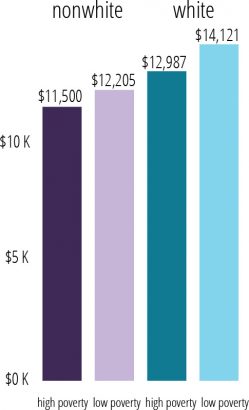Nonwhite school districts get $23 Billion less than white districts despite serving the same number of students
School districts determine the extent to which we can integrate children in a classroom. Their borders can be used to either help remedy or further entrench a deep history of housing segregation. We can draw lines that equalize inherent disparities, or we can allow communities to isolate themselves behind unseen walls of wealth and prosperity—ensuring privilege remains solely within the grasp of the lucky few. Far too often, we choose the latter path.
The racial and economic segregation created by gerrymandered school district boundaries continues to divide our communities and rob our nation’s children of fundamental freedoms and opportunity. Families with money or status can retain both by drawing and upholding invisible lines. Many families do just that. This, in conjunction with housing segregation, ensures that—rather than a partial remedy—district geographies serve to further entrench society’s deep divisions of opportunity.
Good schools can’t solve structural inequality on their own, but neither can it be solved without them. Without an effective education, our children’s futures are all but guaranteed to succumb to the imposed conditions of their lineage and location. And even after Brown v Board, even after decades of school finance litigation meant to equalize the playing field, and even after accounting for wealth disparities, the wrenching reality endures—the United States still invests significantly more money to educate children in white communities.
Taken together, these facts lay bare a simple truth: We haven’t gone far enough.

The national story
Despite more than a half-century of integration efforts, the majority of America’s school children still attend racially concentrated school systems. This is reflective of the long history of segregation—policies related to everything from voting to housing—that have drawn lines and divided our communities.
27% of students are enrolled in predominantly nonwhite districts. * 26% of students are enrolled in predominantly white districts. †
Race and class are inextricably linked in the U.S. When comparing the poverty level of racially concentrated systems, a clear divide emerges. Predominantly white districts are far better off than their heavily nonwhite peers. These statistics confirm what we know about income inequality and the effects of segregation.
In the United States, 20% of students are enrolled in districts that are both poor and nonwhite,* but just 5% of students live in white districts that are equally financially challenged.†
Small districts can have the effect of concentrating resources and amplifying political power. Because schools rely heavily on local taxes, drawing borders around small, wealthy communities benefits the few at the detriment of the many.
White districts enroll just over 1,500 students— half the size of the national average, and nonwhite districts serve over 10,000 students— three times more than that average.
For decades, courts have endorsed the idea of “local control” by demanding that states fill in the financial gaps created by district gerrymandering. In doing so, they have ignored—or even endorsed—the CONTINUE READING: Education Research Report: Nonwhite school districts get $23 Billion less than white districts despite serving the same number of students

